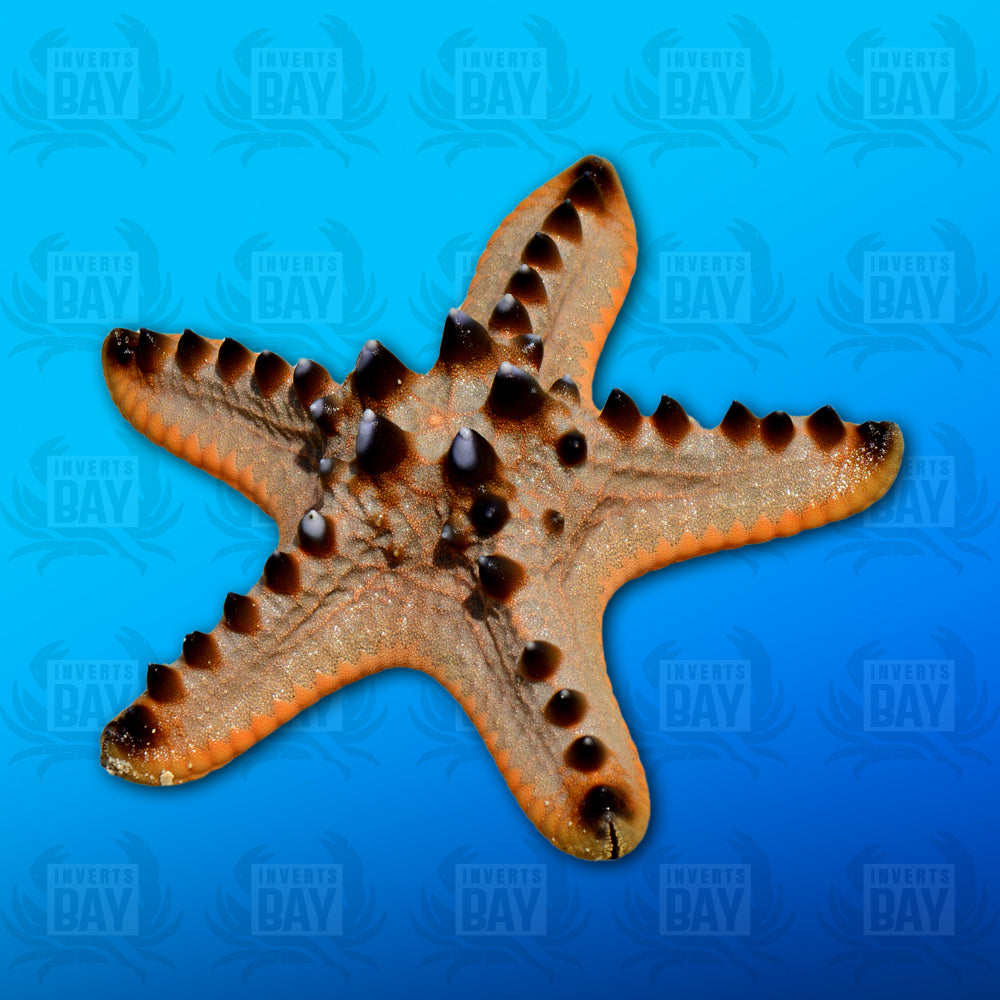(!) Online orders may be adjusted or canceled in the event of pricing errors or unavailable items.
1
/
de
1
Inverts Bay
Chocolate Chip Starfish
Chocolate Chip Starfish
Prix habituel
$30.00 CAD
Prix habituel
Prix promotionnel
$30.00 CAD
Prix unitaire
/
par
Frais d'expédition calculés à l'étape de paiement.
Impossible de charger la disponibilité du service de retrait
The Chocolate Chip Sea Star (Protoreaster nodosus) is a distinctive and popular marine invertebrate known for the dark, cone-shaped protuberances on its arms, resembling chocolate chips. While visually striking, this species requires specific care considerations to thrive in a home aquarium.
Essential Information:
- Common Names: Chocolate Chip Sea Star, Chocolate Chip Starfish, Horned Sea Star
- Scientific Name: Protoreaster nodosus
- Family: Oreasteridae
- Origin/Habitat: Native to the Indo-Pacific region, including areas like the Solomon Islands and Indonesia. They inhabit sandy or muddy substrates in shallow coastal waters.
- Maximum Size: Typically reaches up to 16 inches (40 cm) in diameter, though most individuals in captivity are between 8 to 10 inches (20–25 cm).
- Lifespan: In the wild, they can live up to 17 years; in captivity, with proper care, they often live between 7 to 10 years.
- Level of Difficulty: Moderate; suitable for aquarists with some experience in marine invertebrate care.
- Reef Safe: No; they are known to feed on sessile invertebrates, including corals and sponges, making them unsuitable for reef aquariums.
Appearance & Physical Traits:
- Coloration & Pattern: Features a tan to light brown body adorned with prominent, dark brown to black tubercles ("chocolate chips") on the dorsal surface.
- Body Shape & Structure: Exhibits a classic starfish shape with five stout arms radiating from a central disc. Some individuals may have anomalies, such as four or six arms.
Habitat & Environmental Needs:
- Minimum Tank Size: A well-established marine aquarium of at least 30 gallons (114 liters) is recommended to provide adequate space and stable water conditions.
- Water Temperature: Prefers temperatures between 72–78°F (22–25.5°C).
- pH Level: Maintains best health in water with a pH of 8.1–8.4.
- Specific Gravity: Ideal specific gravity ranges from 1.023 to 1.025.
- Aquascape: Requires a sandy substrate with ample live rock structures to explore and forage. Ensure the aquascape is stable to prevent injury from shifting rocks.
Diet & Feeding:
- Diet Type: Omnivorous scavenger
- Preferred Foods: Feeds on detritus, algae, and various invertebrates. In captivity, their diet can be supplemented with meaty foods such as mussels, shrimp, and squid. Caution is advised, as they may prey on sessile invertebrates, including corals and sponges.
- Feeding Frequency: Offer supplemental feedings 2–3 times per week, placing food items near the sea star to facilitate consumption.
Behavior & Compatibility:
- Temperament: Generally peaceful and slow-moving
- Social Behavior: Solitary; does not require companions and may exhibit territorial behavior towards other sea stars.
- Tank Mate Compatibility: Not suitable for reef tanks due to its tendency to consume corals and other sessile invertebrates. Compatible with non-aggressive fish and invertebrates that do not pose a threat to the sea star.
- Activity Level: Primarily nocturnal; most active during nighttime hours.
Care Considerations & Additional Notes:
- Ease of Care: Requires stable water parameters and a mature aquarium environment. Sensitive to sudden changes in salinity, temperature, and pH.
- Special Requirements: Avoid exposure to air during handling, as this can cause stress and potential injury. Ensure all tank inhabitants are compatible and will not harm or outcompete the sea star for food.
- Breeding Info: Reproduction in captivity is rare and not well-documented. In the wild, they are broadcast spawners, releasing eggs and sperm into the water column.
- Additional Notes: Regular monitoring of water quality is essential, as Chocolate Chip Sea Stars are intolerant of poor conditions. Quarantine new additions to the tank to prevent the introduction of pathogens.
Share

